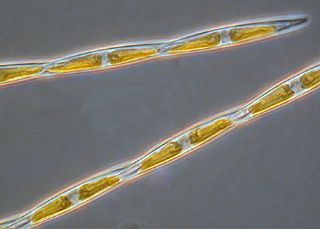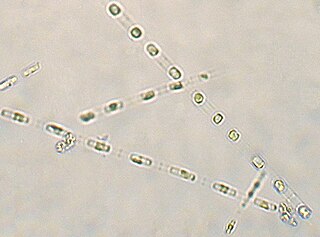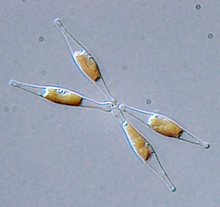
A diatom is any member of a large group comprising several genera of algae, specifically microalgae, found in the oceans, waterways and soils of the world. Living diatoms make up a significant portion of the Earth's biomass: they generate about 20 to 50 percent of the oxygen produced on the planet each year, take in over 6.7 billion tonnes of silicon each year from the waters in which they live, and constitute nearly half of the organic material found in the oceans. The shells of dead diatoms can reach as much as a half-mile deep on the ocean floor, and the entire Amazon basin is fertilized annually by 27 million tons of diatom shell dust transported by transatlantic winds from the African Sahara, much of it from the Bodélé Depression, which was once made up of a system of fresh-water lakes.
Fucoxanthin is a xanthophyll, with formula C42H58O6. It is found as an accessory pigment in the chloroplasts of brown algae and most other heterokonts, giving them a brown or olive-green color. Fucoxanthin absorbs light primarily in the blue-green to yellow-green part of the visible spectrum, peaking at around 510-525 nm by various estimates and absorbing significantly in the range of 450 to 540 nm.

Asterionella is a genus of pennate freshwater diatoms. They are frequently found in star-shaped colonies of individuals.

The Coscinodiscophyceae are a class(s) of diatoms. They are similar to the Centrales, a traditional, paraphyletic subdivision of the heterokont algae known as diatoms. The order is named for the shape of the cell walls of centric diatoms, which are circular or ellipsoid in valve view. The valves often bear radially symmetrical ornamental patterns that can appear as dots when viewed with an optical microscope. Some also bear spines on their valves, which may either increase cell surface area and reduce sinking, or act as a deterrent to zooplankton grazers. Unlike pennate diatoms, centric diatoms never have a raphe.
In certain species of diatoms, auxospores are specialised cells that are produced at key stages in their cell cycle or life history. Auxospores typically play a role in growth processes, sexual reproduction or dormancy.

Thalassiosira pseudonana is a species of marine centric diatoms. It was chosen as the first eukaryotic marine phytoplankton for whole genome sequencing. T. pseudonana was selected for this study because it is a model for diatom physiology studies, belongs to a genus widely distributed throughout the world's oceans, and has a relatively small genome at 34 mega base pairs. Scientists are researching on diatom light absorption, using the marine diatom of Thalassiosira. The diatom requires a high enough concentration of CO2 in order to utilize C4 metabolism (Clement et al. 2015).

Algae fuel, algal biofuel, or algal oil is an alternative to liquid fossil fuels that uses algae as its source of energy-rich oils. Also, algae fuels are an alternative to commonly known biofuel sources, such as corn and sugarcane. When made from seaweed (macroalgae) it can be known as seaweed fuel or seaweed oil.

Ochrophytes are the photosynthetic stramenopiles, a group of eukaryotes characterized by the presence of two unequal flagella, one of which has tripartite hairs called mastigonemes. In particular, ochrophytes are characterized by their plastids enclosed by four membranes, with thylakoids organized in piles of three, and the presence of chlorophylls a, c, and additional pigments such as β-carotene and xanthophylls. Ochrophytes are one of the most diverse lineages of eukaryotes, containing ecologically important algae such as brown algae and diatoms. They are classified either as phylum Ochrophyta or subphylum Ochrophytina within phylum Gyrista. Their plastid is of red algal origin.

Pseudo-nitzschia is a marine planktonic diatom genus that accounts for 4.4% of pennate diatoms found worldwide. Some species are capable of producing the neurotoxin domoic acid (DA), which is responsible for the neurological disorder in humans known as amnesic shellfish poisoning (ASP). Currently, 58 species are known, 28 of which have been shown to produced DA. It was originally hypothesized that only dinoflagellates could produce harmful algal toxins, but a deadly bloom of Pseudo-nitzschia occurred in 1987 in the bays of Prince Edward Island, Canada, and led to an outbreak of ASP. Over 100 people were affected by this outbreak after consuming contaminated mussels; three people died. Since this event, no additional deaths have been attributed to ASP, though the prevalence of toxic diatoms and DA has increased worldwide. This anomaly is likely due to increased awareness of harmful algal blooms (HABs) and their implications for human and ecosystem health.

Nannochloropsis is a genus of algae comprising six known species. The genus in the current taxonomic classification was first termed by Hibberd (1981). The species have mostly been known from the marine environment but also occur in fresh and brackish water. All of the species are small, nonmotile spheres which do not express any distinct morphological features that can be distinguished by either light or electron microscopy. The characterisation is mostly done by rbcL gene and 18S rRNA sequence analysis.

Ditylum brightwellii is a species of cosmopolitan marine centric diatoms. It is a unicellular photosynthetic autotroph that has the ability to divide rapidly and contribute to spring phytoplankton blooms.

5-Fluoroorotic acid (5FOA) is a fluorinated derivative of the pyrimidine precursor orotic acid. It is used in yeast genetics to select for the absence of the URA3 gene, which encodes the enzyme for the decarboxylation of 5-fluoroorotic acid to 5-fluorouracil, a toxic metabolite. It has also been used in diatom selection.

Thalassiosira is a genus of centric diatoms, comprising over 100 marine and freshwater species. It is a diverse group of photosynthetic eukaryotes that make up a vital part of marine and freshwater ecosystems, in which they are key primary producers and essential for carbon cycling
Aureochromes are blue light photoreceptors as well as transcription factors found only in stramenopiles so far.

Marine protists are defined by their habitat as protists that live in marine environments, that is, in the saltwater of seas or oceans or the brackish water of coastal estuaries. Life originated as marine single-celled prokaryotes and later evolved into more complex eukaryotes. Eukaryotes are the more developed life forms known as plants, animals, fungi and protists. Protists are the eukaryotes that cannot be classified as plants, fungi or animals. They are mostly single-celled and microscopic. The term protist came into use historically as a term of convenience for eukaryotes that cannot be strictly classified as plants, animals or fungi. They are not a part of modern cladistics because they are paraphyletic.

Diatoms belong to a large group called the heterokonts, which include both autotrophs such as golden algae and kelp; and heterotrophs such as water moulds. The classification of heterokonts is still unsettled: they may be designated a division, phylum, kingdom, or something intermediate to those. Consequently, diatoms are ranked anywhere from a class, usually called Diatomophyceae or Bacillariophyceae, to a division (=phylum), usually called Bacillariophyta, with corresponding changes in the ranks of their subgroups.
Linda Karen Medlin is a molecular biologist known for her work on diatoms. She is an elected member of the Norwegian Academy of Science and Letters.

Skeletonema costatum is a cosmopolitan centric diatom that belongs to the genus Skeletonema. It was first described by R. K. Greville, who originally named it Melosira costata, in 1866. It was later renamed by Cleve in 1873 and was more narrowly defined by Zingone et al. and Sarno et al. Skeletonemacostatum is the most well known species of the genus Skeletonema and is often one of the dominant species responsible for red tide events.

2-Fluoroadenine (2-FA) is a toxic adenine antimetabolite which can be used in laboratory biological research for counterselection of wildtype bacterial or eukaryotic APT genes. Therefore, knockouts or mutants for APT, which are resistant to 2-FA, can be selected.
Algal viruses are the viruses infecting photosynthetic single-celled eukaryotes, algae. As of 2020, there were 61 viruses known to infect algae. Algae are integral components of aquatic food webs and drive nutrient cycling, so the viruses infecting algal populations also impacts the organisms and nutrient cycling systems that depend on them. Thus, these viruses can have significant, worldwide economic and ecological effects. Their genomes varied between 4.4 to 560 kilobase pairs (kbp) long and used double-stranded Deoxyribonucleic Acid (dsDNA), double-stranded Ribonucleic Acid (dsRNA), single-stranded Deoxyribonucleic Acid (ssDNA), and single-stranded Ribonucleic Acid (ssRNA). The viruses ranged between 20 and 210 nm in diameter. Since the discovery of the first algae-infecting virus in 1979, several different techniques have been used to find new viruses infecting algae and it seems that there are many algae-infecting viruses left to be discovered
















